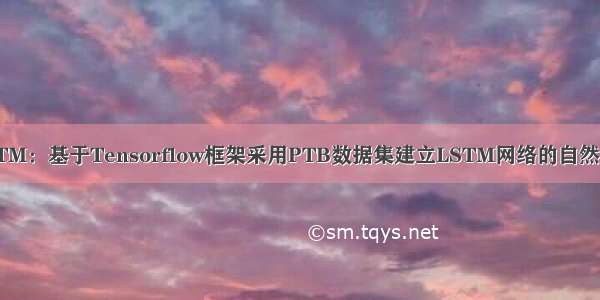
TF之LSTM:基于Tensorflow框架采用PTB数据集建立LSTM网络的自然语言建模
目录
关于PTB数据集
代码实现
关于PTB数据集
PTB (Penn Treebank Dataset)文本数据集是语言模型学习中目前最被广泛使用数据集。
ptb.test.txt #测试集数据文件
ptb.train.txt #训练集数据文件
ptb.valid.txt #验证集数据文件
这三个数据文件中的数据已经经过了预处理,包含了10000 个不同的词语和语句结束标记符(在文本中就是换行符)以及标记稀有词语的特殊符号。
为了让使用PTB数据集更加方便,TensorFlow提供了两个函数来帮助实现数据的预处理。首先,TensorFlow提供了ptb_raw_data函数来读取PTB的原始数据,并将原始数据中的单词转化为单词ID。
训练数据中总共包含了929589 个单词,而这些单词被组成了一个非常长的序列。这个序列通过特殊的标识符给出了每句话结束的位置。在这个数据集中,句子结束的标识符ID为2。
数据集的下载地址:TF的PTB数据集 (别的数据集不匹配的话会出现错误)
代码实现
本代码使用2层 LSTM 网络,且每层有 200 个隐藏单元。在训练中截断的输入序列长度为 32,且使用 Dropout 和梯度截断等方法控制模型的过拟合与梯度爆炸等问题。当简单地训练 3 个 Epoch 后,测试复杂度(Perplexity)降低到了 210,如果多轮训练会更低。
# -*- coding: utf-8 -*-from __future__ import absolute_importfrom __future__ import divisionfrom __future__ import print_functionimport collectionsimport osimport sysimport tensorflow as tfPy3 = sys.version_info[0] == 3def _read_words(filename):with tf.gfile.GFile(filename, "r") as f:if Py3:return f.read().replace("\n", "<eos>").split()else:return f.read().decode("utf-8").replace("\n", "<eos>").split()def _build_vocab(filename):data = _read_words(filename)counter = collections.Counter(data)count_pairs = sorted(counter.items(), key=lambda x: (-x[1], x[0]))words, _ = list(zip(*count_pairs))word_to_id = dict(zip(words, range(len(words))))return word_to_iddef _file_to_word_ids(filename, word_to_id):data = _read_words(filename)return [word_to_id[word] for word in data if word in word_to_id]def ptb_raw_data(data_path=None):"""Load PTB raw data from data directory "data_path".Reads PTB text files, converts strings to integer ids,and performs mini-batching of the inputs.The PTB dataset comes from Tomas Mikolov's webpage:http://www.fit.vutbr.cz/~imikolov/rnnlm/simple-examples.tgzArgs:data_path: string path to the directory where simple-examples.tgz hasbeen extracted.Returns:tuple (train_data, valid_data, test_data, vocabulary)where each of the data objects can be passed to PTBIterator."""train_path = os.path.join(data_path, "ptb.train.txt")valid_path = os.path.join(data_path, "ptb.valid.txt")test_path = os.path.join(data_path, "ptb.test.txt")word_to_id = _build_vocab(train_path)train_data = _file_to_word_ids(train_path, word_to_id)valid_data = _file_to_word_ids(valid_path, word_to_id)test_data = _file_to_word_ids(test_path, word_to_id)vocabulary = len(word_to_id)return train_data, valid_data, test_data, vocabularydef ptb_producer(raw_data, batch_size, num_steps, name=None):"""Iterate on the raw PTB data.This chunks up raw_data into batches of examples and returns Tensors thatare drawn from these batches.Args:raw_data: one of the raw data outputs from ptb_raw_data.batch_size: int, the batch size.num_steps: int, the number of unrolls.name: the name of this operation (optional).Returns:A pair of Tensors, each shaped [batch_size, num_steps]. The second elementof the tuple is the same data time-shifted to the right by one.Raises:tf.errors.InvalidArgumentError: if batch_size or num_steps are too high."""with tf.name_scope(name, "PTBProducer", [raw_data, batch_size, num_steps]):raw_data = tf.convert_to_tensor(raw_data, name="raw_data", dtype=tf.int32)data_len = tf.size(raw_data)batch_len = data_len // batch_sizedata = tf.reshape(raw_data[0 : batch_size * batch_len],[batch_size, batch_len])epoch_size = (batch_len - 1) // num_stepsassertion = tf.assert_positive(epoch_size,message="epoch_size == 0, decrease batch_size or num_steps")with tf.control_dependencies([assertion]):epoch_size = tf.identity(epoch_size, name="epoch_size")i = tf.train.range_input_producer(epoch_size, shuffle=False).dequeue()x = tf.strided_slice(data, [0, i * num_steps],[batch_size, (i + 1) * num_steps])x.set_shape([batch_size, num_steps])y = tf.strided_slice(data, [0, i * num_steps + 1],[batch_size, (i + 1) * num_steps + 1])y.set_shape([batch_size, num_steps])return x, y
from reader import *import tensorflow as tfimport numpy as npdata_path = 'F:/File_Python/Python_daydayup/data/simple-examples/data' #F:/File_Python/Python_daydayup/data/simple-examples/data# 隐藏层单元数与LSTM层级数hidden_size = 200num_layers = 2#词典规模vocab_size = 10000learning_rate = 1.0train_batch_size = 16# 训练数据截断长度train_num_step = 32# 在测试时不需要使用截断,测试数据为一个超长序列eval_batch_size = 1eval_num_step = 1num_epoch = 3#结点不被Dropout的概率keep_prob = 0.5# 用于控制梯度爆炸的参数max_grad_norm = 5# 通过ptbmodel 的类描述模型class PTBModel(object):def __init__(self, is_training, batch_size, num_steps):# 记录使用的Batch大小和截断长度self.batch_size = batch_sizeself.num_steps = num_steps# 定义输入层,维度为批量大小×截断长度self.input_data = tf.placeholder(tf.int32, [batch_size, num_steps])# 定义预期输出self.targets = tf.placeholder(tf.int32, [batch_size, num_steps])# 定义使用LSTM结构为循环体,带Dropout的深度RNNlstm_cell = tf.nn.rnn_cell.BasicLSTMCell(hidden_size)if is_training:lstm_cell = tf.nn.rnn_cell.DropoutWrapper(lstm_cell, output_keep_prob=keep_prob)cell = tf.nn.rnn_cell.MultiRNNCell([lstm_cell] * num_layers)# 初始化状态为0self.initial_state = cell.zero_state(batch_size, tf.float32)# 将单词ID转换为单词向量,embedding的维度为vocab_size*hidden_sizeembedding = tf.get_variable('embedding', [vocab_size, hidden_size])# 将一个批量内的单词ID转化为词向量,转化后的输入维度为批量大小×截断长度×隐藏单元数inputs = tf.nn.embedding_lookup(embedding, self.input_data)# 只在训练时使用Dropoutif is_training: inputs = tf.nn.dropout(inputs, keep_prob)# 定义输出列表,这里先将不同时刻LSTM的输出收集起来,再通过全连接层得到最终输出outputs = []# state 储存不同批量中LSTM的状态,初始为0state = self.initial_statewith tf.variable_scope('RNN'):for time_step in range(num_steps):if time_step > 0: tf.get_variable_scope().reuse_variables()# 从输入数据获取当前时间步的输入与前一时间步的状态,并传入LSTM结构cell_output, state = cell(inputs[:, time_step, :], state)# 将当前输出加入输出队列outputs.append(cell_output)# 将输出队列展开成[batch,hidden*num_step]的形状,再reshape为[batch*num_step, hidden]output = tf.reshape(tf.concat(outputs, 1), [-1, hidden_size])# 将LSTM的输出传入全连接层以生成最后的预测结果。最后结果在每时刻上都是长度为vocab_size的张量# 且经过softmax层后表示下一个位置不同词的概率weight = tf.get_variable('weight', [hidden_size, vocab_size])bias = tf.get_variable('bias', [vocab_size])logits = tf.matmul(output, weight) + bias# 定义交叉熵损失函数,一个序列的交叉熵之和loss = tf.contrib.legacy_seq2seq.sequence_loss_by_example([logits], # 预测的结果[tf.reshape(self.targets, [-1])], # 期望正确的结果,这里将[batch_size, num_steps]压缩为一维张量[tf.ones([batch_size * num_steps], dtype=tf.float32)]) # 损失的权重,所有为1表明不同批量和时刻的重要程度一样# 计算每个批量的平均损失self.cost = tf.reduce_sum(loss) / batch_sizeself.final_state = state# 只在训练模型时定义反向传播操作if not is_training: returntrainable_variable = tf.trainable_variables()# 控制梯度爆炸问题grads, _ = tf.clip_by_global_norm(tf.gradients(self.cost, trainable_variable), max_grad_norm)# 如果需要使用Adam作为优化器,可以改为tf.train.AdamOptimizer(learning_rate),学习率需要降低至0.001左右optimizer = tf.train.GradientDescentOptimizer(learning_rate)# 定义训练步骤self.train_op = optimizer.apply_gradients(zip(grads, trainable_variable))def run_epoch(session, model, data, train_op, output_log, epoch_size):total_costs = 0.0iters = 0state = session.run(model.initial_state)# # 使用当前数据训练或测试模型for step in range(epoch_size):x, y = session.run(data)# 在当前批量上运行train_op并计算损失值,交叉熵计算的是下一个单词为给定单词的概率cost, state, _ = session.run([model.cost, model.final_state, train_op],{model.input_data: x, model.targets: y, model.initial_state: state})# 将不同时刻和批量的概率就可得到困惑度的对数形式,将这个和做指数运算就可得到困惑度total_costs += costiters += model.num_steps# 只在训练时输出日志if output_log and step % 100 == 0:print("After %d steps, perplexity is %.3f" % (step, np.exp(total_costs / iters)))return np.exp(total_costs / iters)def main():train_data, valid_data, test_data, _ = ptb_raw_data(data_path)# 计算一个epoch需要训练的次数train_data_len = len(train_data)train_batch_len = train_data_len // train_batch_sizetrain_epoch_size = (train_batch_len - 1) // train_num_stepvalid_data_len = len(valid_data)valid_batch_len = valid_data_len // eval_batch_sizevalid_epoch_size = (valid_batch_len - 1) // eval_num_steptest_data_len = len(test_data)test_batch_len = test_data_len // eval_batch_sizetest_epoch_size = (test_batch_len - 1) // eval_num_stepinitializer = tf.random_uniform_initializer(-0.05, 0.05)with tf.variable_scope("language_model", reuse=None, initializer=initializer):train_model = PTBModel(True, train_batch_size, train_num_step)with tf.variable_scope("language_model", reuse=True, initializer=initializer):eval_model = PTBModel(False, eval_batch_size, eval_num_step)# 训练模型。with tf.Session() as session:tf.global_variables_initializer().run()train_queue = ptb_producer(train_data, train_model.batch_size, train_model.num_steps)eval_queue = ptb_producer(valid_data, eval_model.batch_size, eval_model.num_steps)test_queue = ptb_producer(test_data, eval_model.batch_size, eval_model.num_steps)coord = tf.train.Coordinator()threads = tf.train.start_queue_runners(sess=session, coord=coord)for i in range(num_epoch):print("In iteration: %d" % (i + 1))run_epoch(session, train_model, train_queue, train_model.train_op, True, train_epoch_size)valid_perplexity = run_epoch(session, eval_model, eval_queue, tf.no_op(), False, valid_epoch_size)print("Epoch: %d Validation Perplexity: %.3f" % (i + 1, valid_perplexity))test_perplexity = run_epoch(session, eval_model, test_queue, tf.no_op(), False, test_epoch_size)print("Test Perplexity: %.3f" % test_perplexity)coord.request_stop()coord.join(threads)if __name__ == "__main__":main()
如果觉得《TF之LSTM:基于Tensorflow框架采用PTB数据集建立LSTM网络的自然语言建模》对你有帮助,请点赞、收藏,并留下你的观点哦!














